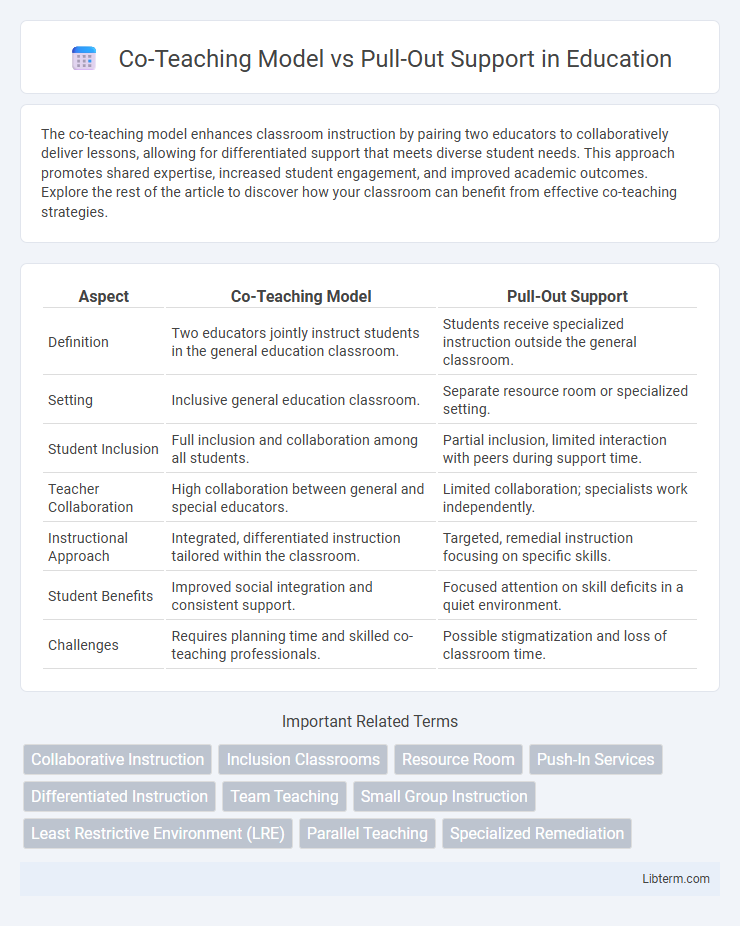The co-teaching model enhances classroom instruction by pairing two educators to collaboratively deliver lessons, allowing for differentiated support that meets diverse student needs. This approach promotes shared expertise, increased student engagement, and improved academic outcomes. Explore the rest of the article to discover how your classroom can benefit from effective co-teaching strategies.
Table of Comparison
| Aspect | Co-Teaching Model | Pull-Out Support |
|---|---|---|
| Definition | Two educators jointly instruct students in the general education classroom. | Students receive specialized instruction outside the general classroom. |
| Setting | Inclusive general education classroom. | Separate resource room or specialized setting. |
| Student Inclusion | Full inclusion and collaboration among all students. | Partial inclusion, limited interaction with peers during support time. |
| Teacher Collaboration | High collaboration between general and special educators. | Limited collaboration; specialists work independently. |
| Instructional Approach | Integrated, differentiated instruction tailored within the classroom. | Targeted, remedial instruction focusing on specific skills. |
| Student Benefits | Improved social integration and consistent support. | Focused attention on skill deficits in a quiet environment. |
| Challenges | Requires planning time and skilled co-teaching professionals. | Possible stigmatization and loss of classroom time. |
Introduction to Co-Teaching and Pull-Out Support
Co-Teaching involves two educators collaborating within the same classroom to deliver instruction simultaneously, enhancing student engagement and differentiated learning. Pull-Out Support extracts students from the general education setting for targeted, specialized assistance outside the regular classroom, focusing on individualized skill development. Both models aim to support diverse learning needs but differ in instructional delivery and classroom integration.
Defining the Co-Teaching Model
The Co-Teaching Model involves two educators collaboratively delivering instruction in the same classroom to support diverse learner needs. This approach contrasts with Pull-Out Support, where students exit the general education setting for specialized instruction. Co-Teaching promotes inclusive education by integrating differentiated teaching strategies within the general classroom environment.
Understanding Pull-Out Support
Pull-Out Support involves removing students from the general education classroom for specialized instruction in areas such as reading, math, or speech therapy, targeting specific skills outside the mainstream environment. This approach allows focused, individualized attention from specialists but may limit students' access to general curriculum and peer interactions. Unlike the Co-Teaching Model, where educators collaborate within the classroom setting, Pull-Out Support operates separately, emphasizing tailored interventions that address distinct learning needs.
Key Differences Between Co-Teaching and Pull-Out
Co-teaching involves two educators collaboratively delivering instruction within the same classroom, promoting inclusive learning and real-time differentiation, whereas pull-out support removes students from the general classroom for specialized, individualized help. Co-teaching emphasizes shared responsibility and dynamic interaction between general and special educators, while pull-out support focuses on targeted intervention in a separate setting, often limiting peer interaction. Key differences include the setting of instruction, level of integration with peers, and collaborative teaching versus individualized support approaches.
Benefits of the Co-Teaching Model
The Co-Teaching Model provides inclusive education by integrating general and special education teachers in the same classroom, enhancing individualized support for diverse learners. This collaboration allows for real-time differentiation and immediate intervention, improving academic outcomes and social interaction among students. Compared to Pull-Out Support, co-teaching fosters a more cohesive learning environment that reduces stigma and promotes consistent access to the general curriculum.
Advantages of Pull-Out Support
Pull-out support offers targeted, individualized assistance that addresses specific learning gaps, enabling students to receive focused instruction outside the general classroom setting. This model allows specialists to customize interventions based on detailed assessments, promoting accelerated academic progress. Pull-out sessions can minimize distractions, providing a supportive environment tailored to the student's unique educational needs.
Challenges of Co-Teaching Approaches
Co-teaching models face challenges such as insufficient collaboration time between general and special education teachers, which can hinder lesson planning and consistency. Differences in teaching styles and classroom management approaches may lead to conflicts, impacting instruction quality and student engagement. Limited professional development focused on co-teaching strategies often reduces the effectiveness of inclusive education initiatives compared to pull-out support models.
Drawbacks of Pull-Out Support
Pull-Out Support often disrupts students' connection with the general education curriculum, leading to gaps in content mastery and social integration. This approach may stigmatize students by isolating them, negatively impacting their self-esteem and peer relationships. Limited collaboration with classroom teachers reduces the alignment of instruction, resulting in fragmented learning experiences and inconsistent progress monitoring.
Selecting the Best Model for Student Needs
Selecting the best model for student needs requires analyzing the specific learning goals and the level of support needed. The Co-Teaching Model offers inclusive, collaborative instruction within the general classroom, maximizing peer interaction and immediate support, which benefits students requiring consistent scaffolding. Pull-Out Support provides targeted, intensive intervention outside the classroom, ideal for students needing specialized focus without distractions, but may reduce exposure to the general education curriculum and peer collaboration opportunities.
Conclusion: Co-Teaching vs Pull-Out Effectiveness
Co-teaching models foster inclusive classroom environments by integrating special education and general education teachers to collaboratively support diverse learners, which enhances student engagement and social interaction. Pull-out support offers targeted, individualized intervention outside the general classroom but may isolate students and limit access to core content and peer learning opportunities. Research suggests co-teaching is generally more effective for promoting academic achievement and social integration, while pull-out support benefits specific skill remediation.
Co-Teaching Model Infographic

 libterm.com
libterm.com